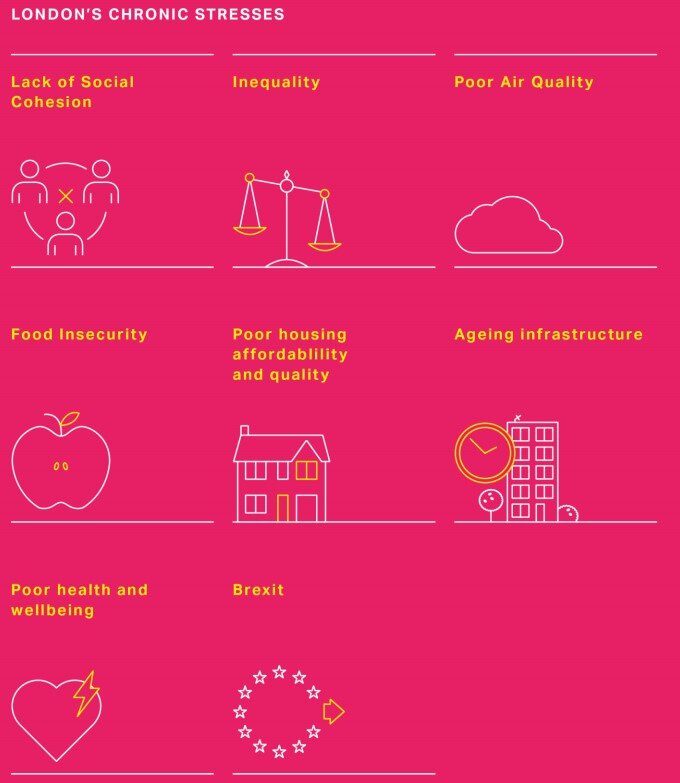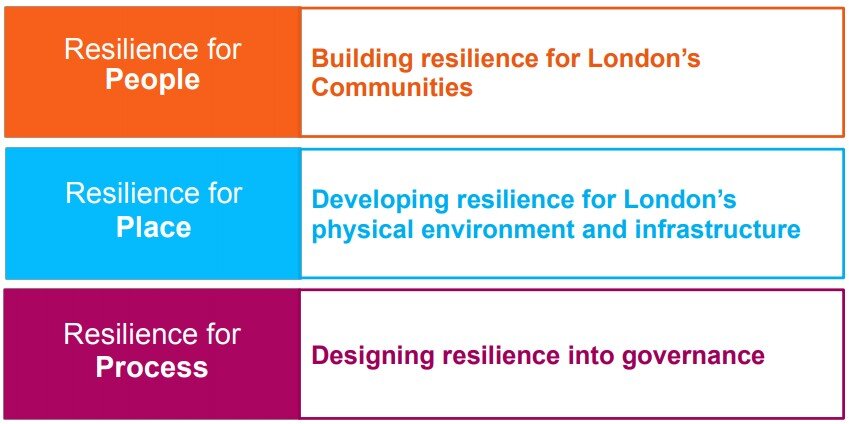Be in the know: the London Resilience Plan
Earlier this year, the Greater London Authority (GLA) published its Resilience Strategy for London using a City Resilience Framework. This is part of a wider global initiative, 100 Resilient Cities (100RC), pioneered by the Rockefeller Foundation to identify critical areas of weakness, and to identify actions and programs to improve the city’s resilience.
Resilience is defined as “the capacity of individuals, communities, institutions, businesses, and systems within a city to survive, adapt, and thrive no matter what kinds of chronic stresses and acute shocks they experience” – 100 RC.
If there was ever a year where a city like London needed to be resilient, 2020 would be it. With the stress of a global pandemic hitting London hard, we need to understand the capacity of our existing communities, places and processes. Of course, it’s easier to do this with hindsight, but as the document was published in February 2020 (pre-lockdown) it is evident just by looking at the contents page of the report that climate change, sustainability, cyber security and governance are the dominant themes.
The document outlines London’s major ‘shocks’ and ‘chronic stresses’ which were identified through discussion with stakeholders, a review of the risk data underpinning existing Mayoral Strategies, workshops using 100RC tools, and a review of the London Risk Register. These are shown below:
Image: London City Resilience Strategy 2020
Image: London City Resilience Strategy 2020
The proposed resilience projects within the report are split into People, Places and Processes.
Image: London City Resilience Strategy 2020
Examples of each include:
A) People - Extreme heat management, food security, and using water sustainably.
B) Place – Resilient and zero carbon infrastructure, cyber emergency response capability, and innovative data use for infrastructure.
C) Process - Preparing for a cashless society, counter terrorism collaboration, and quantifying the cost of disruption.
I read this document with the COVID-19 pandemic at the forefront of my mind, and looked through the projects which supposedly address the ‘shock’ of a disease pandemic. The four initiatives below are mentioned in the document which supposedly contribute to London being resilient to a disease pandemic.
A5 – Community Risk Communication
Development of a risk communication programme that reviews and explores leading practice, perception and effectiveness of public risk communication. It will include determining organisational responsibilities for specific risk communication from within London and nationally (e.g. Catch it, Bin it, Kill it or Run, Hide, Tell). This project also aims to develop active ways of communicating at a local level through a London Community Resilience week event in partnership with London boroughs and others.
A6 – Scenario Planning and Theatre
Scenario planning and training exercises is a major part of emergency preparedness. Exercises aim to test and to improve emergency plans and prepare responders to deal with any incidents that may occur. The aim of this project is to collaborate with a theatre company to co-develop scenario planning exercises with responders that involve members of the public, and in doing so pioneer new approaches to building resilience.
B5 – Innovative data use for infrastructure
This project aims to use data innovation to facilitate more effective action. By identifying and compiling data that already exists, it’s possible to generate insights to inform decision-making on infrastructure in London. For example, integrated data on infrastructure interdependencies and asset health, allows GLA to work with infrastructure providers to identify where investment should be prioritised to reduce London’s vulnerabilities.
C4 – Addressing Long-Term Risk
This project aims to develop a collaborative approach between London’s policymakers and emergency planners that will improve preparedness for long term shocks and stresses to London, as well as enhance existing emergency plans by bridging the gap between past incidents and future trends.
Now that we are in a ‘shock’ - i.e. in lockdown due to a pandemic, the question remains whether we would have “survived, adapted and thrived” as a city, had we had the above 4 initiatives in place?
If we had a risk communication programme at a local level, if we had planned for this scenario through training exercises, if data of infrastructure was integrated to provide better investment decisions and finally, if there was a collaborative approach between policymakers and emergency planners, would we have been a more resilient city to COVID-19?
Personally, I do not think so. As I said, it’s easy to look at this document in hindsight, but let’s be practical – the only reason why we are failing to be resilient to this virus is largely attributed the delay of the current government in taking action. We had warnings from Italy and Spain, we knew what was coming.
It’s hard to believe that had the initiatives outlined in this new Resilience Strategy been in place, we would have reduced the number of deaths that we are seeing. I believe resilience of a city or nation to deal with something such as a disease pandemic requires immense faith in leadership to do the right thing – take New Zealand as an example. Large scale communications (i.e. Stay at Home, Protect the NHS, Save Lives) isn’t really effective when the actions of the country’s leadership over the last decade has broken down the NHS piece by piece.
In situations like these, resilience of our communities, and therefore businesses and economy, requires us to believe that our leaders are practising what they preach, i.e. putting measures in place to sufficiently fund public services, rather than a meaningless applause once a week.
The London Resilience Strategy can be found in full here.
Words by Ayisha Paw













